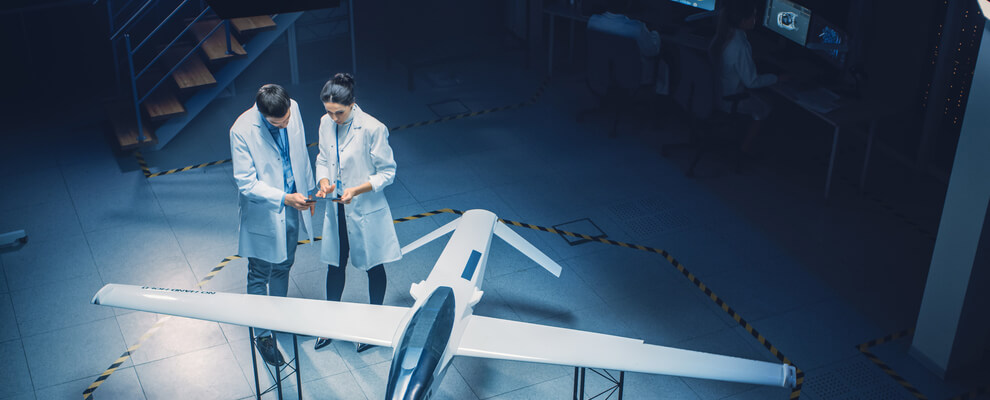The introduction of 3D printing in aerospace has also enabled more efficient creation of complex and customized components, significantly impacting cost and weight parameters. This technological convergence is not just redefining processes but also reimagining the future of the aerospace industry.

AI in Aerospace Manufacturing
AI’s transformative power is being harnessed in numerous ways within manufacturing. It aids in enhancing the reliability of testing strategies, implementing automated test equipment (ATE), and creating a comprehensive test program. These advancements ensure uninterrupted testing in the future, thereby facilitating optimal performance and improved efficiency.
ATE Systems
An ATE system, powered by off-the-shelf (COTS) technology, streamlines the maintenance and obsolescence management of parts. This allows aerospace manufacturers to focus their expertise on producing state-of-the-art assets rather than dedicating resources to developing custom test rack components.
These universally adaptable ATE systems, crafted with industry-standard, upgradable, modular, and open solutions, accommodate both mechanical and electronic component tests.
3D Printing in Aerospace Manufacturing
3D printing, also known as additive manufacturing, is making waves, contributing to significant advancements in efficiency, customization, and cost reduction. This cutting-edge technology enables the creation of components layer by layer, allowing for the production of complex geometries that would be impossible using traditional manufacturing methods.
Aerospace components often have complex designs to withstand high stress, extreme temperatures, and various pressures. Traditional manufacturing methods can struggle to produce such intricate designs cost-effectively. However, 3D printing in aerospace manufacturing allows for the production of these components with greater precision and less material waste. It also enables the incorporation of innovative materials, like specialized polymers and metal alloys, which can significantly enhance component performance.
Customization and Prototyping
3D printing shines in customization and prototyping. Given the diversity of aerospace applications, the need for custom components is high. 3D printing can produce these components swiftly, enabling more rapid iterations in the design and prototyping phases. This agility translates to shorter product development cycles, quicker time-to-market, and thus a significant competitive advantage in the aerospace industry.
Cost and Weight Reduction
3D printing can generate substantial cost savings. By eliminating the need for expensive molds and tooling, and reducing material waste, 3D printing can lower production costs. Moreover, 3D printing allows for the production of lightweight components without compromising strength or integrity. This reduction in weight contributes to more fuel-efficient aircraft, translating to significant operational cost savings over the lifespan of an aircraft.
AI and Smart Radar Systems
With the rapid evolution of the electromagnetic battlefield, traditional radar systems are undergoing significant technology disruption. AI plays a crucial role in overcoming new challenges, such as drone localization. AI-driven technologies enable rapid prototyping of radar waveforms and architectures to counteract emerging threats and assure operation in contested electromagnetic environments.
AI, combined with COTS software-defined radios (SDRs), accelerates the transition from concept to testbed to deployed system. This progression aids in tackling agile, hypersonic weapons, resolving drone swarms, and detecting low-RCS aircraft.
AI’s Influence on Electronic Warfare
Modern radar, electronic warfare, and SIGINT systems are generating, processing, and recording wide signal bandwidths at a broad range of frequencies. Achieving spectrum superiority is crucial for success on the battlefield. AI-driven SDR offers a flexible platform for developing and deploying electronic warfare systems, allowing for adaptability to modern and evolving threats.
The use of AI in COTS technology has also optimized system-level testing of complex, intelligent EW receivers. This reduces the need for flight test hours by modeling and simulating a multi-emitter environment.
Electrical and Mechanical Systems in Aerospace
The efficient operation of aerospace vehicles relies heavily on the flawless functioning of numerous electrical and mechanical subsystems. AI has advanced the testing and integration of these components, ensuring their reliability across all mission scenarios.
AI has significantly improved the efficiency of life cycle or durability tests, aided in the quick integration and synchronization of sensors, signal conditioning, and actuation systems. Also, through the application of AI in the development of high channel count distributed measurement systems, the design of high-performance structural test systems becomes easier.
AI for IoT and Augmented Reality
Digital transformation, underpinned by AI, is a key trend reshaping the aerospace industry. IoT and Augmented Reality (AR), when combined with AI, provide invaluable insights and capabilities to technicians in context to physical equipment, enhancing productivity and operational efficiency.
AR brings substantial benefits to the aerospace and defense industry, in particular, in areas such as manufacturing, service, and training. It not only enhances efficiency and compliance but also ensures safety while reducing costs. AR-based training, coupled with AI, accelerates the onboarding of new workers while improving retention and competency. In instances of unforeseen challenges, AR-enabled remote assistance allows experienced personnel to assist their less experienced colleagues irrespective of physical proximity.
Get Ahead of the Trend
The integration of AI into aerospace is an imperative in this era of digital transformation, and it’s happening already. AI’s vast potential, when harnessed properly, can significantly enhance manufacturing processes, improving efficiency, reducing costs, and driving innovation.
As your trusted partner in this journey, SAAB RDS offers the expertise and resources you need to ensure you are implementing state-of-the-art technologies such as ATE systems, AR or AI into your aerospace applications. Contact SAAB RDS today for a consultation on incorporating these technologies into your aerospace manufacturing processes.
